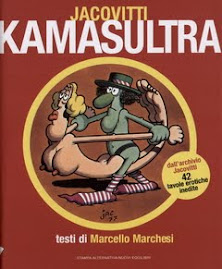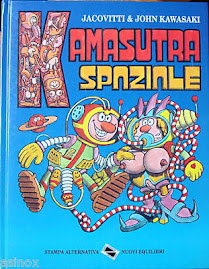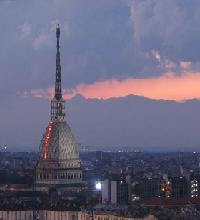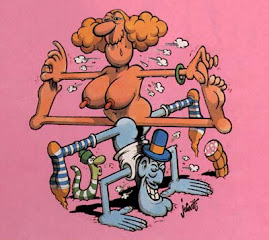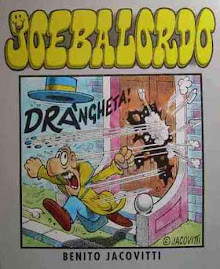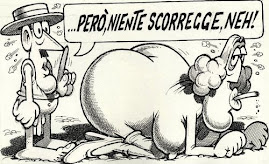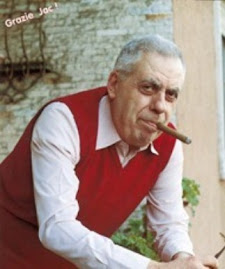mercoledì 10 dicembre 2008
LA FINE ... (THIS IS THE END ...)
Non me ne vogliano i miei amici, visitatori e blogger: no, la causa non è quell'indolenza che ultimamente aveva caratterizzato la mia attività di blogger. Ben più seri motivi mi costringono a ridurre drasticamente la portata del blog - in particolare, una serie di minacce ricevute ...
In ogni caso, INVITO, ANZI CONSIGLIO CALDAMENTE AI MIEI AMICI, VISITATORI E BLOGGER DI CONTATTARMI (SCRIVENDOMI PURE IN ITALIANO, INGLESE, SPAGNOLO E SVEDESE) ALL'INDIRIZZO E-MAIL PRESENTE A LATO, in modo da ... non perderci di vista. Potete anche lasciare il vostro recapito e-mail nell'area 'Commenti' più in basso. Fatelo e non ve ne pentirete!
Pertanto, APPROFITTATENE PER ESPLORARE QUESTO BLOG PRIMA CHE SIA TROPPO TARDI.
Sappiate comunque che continuerò ad essere 'vivo' nel blog "fratello" my book of yesterday and today.
ANONIMO VENEZIANO
In a few days' time, this blog will be closed, or rather, it will be dramatically 'scaled down' and ALL THE MUSIC POSTS WILL BE DELETED.
I hope my friends, visitors and blogger won't be angry at me: I'm not going to drop out because I have got fed up with blogging. A serious situation has occurred, which forces me to dramatically reduce the scope of this blog; in particular, I have been threatened to ...
In any case, I STRONGLY RECOMMEND THAT ALL OF MY FRIENDS, BLOGGER AND VISITORS SHOULD CONTACT ME AT THE E-MAIL ADDRESS SPECIFIED IN THE COLUMN ON THE RIGHT (YOU CAN WRITE TO ME IN ITALIAN, ENGLISH, SPANISH AND SWEDISH), so that I can ... keep in touch with you. You may also let me know your e-mail address in the "Comments" section below. PLEASE, DO IT: IT'S VERY IMPORTANT TO ME!
Therefore, DON'T WASTE ANY TIME AND BROWSE THROUGH THIS BLOG BEFORE IT'S TOO LATE.
Please be informed, however, that I will continue my activity as a blogger by posting in the "brother" blog of mine, i.e. my book of yesterday and today.
ANONIMO VENEZIANO
giovedì 27 novembre 2008
OVO (PETER GABRIEL) - 2000
+-+Front+cover.jpg)
Il concetto che sta alla base dell’album rappresenta una variazione di un tema spesso utilizzato nella musica rock e nell’arte: il succedersi, nel tempo, di tre generazioni di una famiglia. Tuttavia, non si tratta di tre generazioni consecutive: la prima appartiene alla preistoria, la seconda al periodo industriale (grosso modo, l’era attuale), mentre la terza è inevitabilmente proiettata nel futuro. Ovo è il componente più giovane della famiglia - un bambino venuto alla luce nel mondo enigmatico dei suoi genitori e nonni.
Per quanto riguarda la musica, risulta evidente fin dall’inizio che “Ovo” attinge generosamente a quei suoni del "Real world" così tanto approfonditi e adorati da Gabriel da molti anni a questa parte. Non a caso, l’elenco dei musicisti che hanno partecipato alla realizzazione del disco (es. Ravi Shankar, Tony Levin e Richie Havens) sottolinea l’eterogeneità delle timbriche sulle quali si basa l’album.
Un album che sorprende ad un singolo brano. Si passa da una tipica ‘reel’ in stile celtico ("The weaver's reel") ad un’interpretazione vocale soft e introspettiva ("Father, son") e, quindi, ad un pezzo di rock duro vero e proprio ("The tower that ate people") in perfetto stile “Sledgehammer”.
Nelle altre parti dell’album balzano in evidenza i ritmi e le sonorità etniche (con tanto di utilizzo di ‘didgeridoo’). Molti dei brani sono strumentali ispirati a generi diversi (es. "White ashes", con il suo curioso mix di ritmi africani e parti vocali borbottate, il tutto su un continuo va-e-vieni di sintetizzatori). Il brano conclusivo “Make tomorrow” è uno dei più lunghi composti da Gabriel e raduna gran parte dei musicisti presenti nell’album, dando vita ad un grandioso finale.
Pur essendo una sorta di colonna sonora, “Ovo” è un album davvero ‘tosto’: personalmente, lo preferisco a molti degli album solisti pubblicati dall’ex-leader dei Genesis. L’eterogeneità delle musiche, la presenza di artisti di massimo livello e la solidità delle composizioni contribuiscono alla resa di quello che classifico come un ottimo album.
The concept lying at the basis of this album is a variation on an ofted used theme, looking at three generations of a family. These are not consecutive generations: the first is from he prehistoric era, the second from the industrial period (approximately now), and the third, inevitably, in the future. Ovo is the youngest of the family, an infant born into the enigmatic world of his parents and grandparents.
So much for the concept, what of the music? Right from the start it is clear that "Ovo" leans heavily on the "Real world" sounds which Gabriel has investigated and nurtured for many years. A glance at the line-up reveals that such renown musicians as Ravi Shankar, Tony Levin, and Richie Havens have all contributed to the diverse sounds on which the album is built.
There really is something for everyone here. One minute we are being uplifted by a Celtic reel ("The weaver's reel"), the next we have a delicate Gabriel vocal song ("Father, son") and, no sooner that has finished, we have a "Sledgehammer"-type piece of heavy rock ("The tower that ate people").
Elsewhere, ethnic rhythms come to the fore (including didgeridoos). Several of the tracks are instrumentals of various styles, e.g. "White ashes" with its curious mix of African type rhythms and mumbled vocalizing, with synthesizer effects drifting in and out. The album closes with one of Gabriel's longest songs ever: "Make tomorrow". The piece brings together many of the musicians who have graced previous tracks in a slightly understated but highly effective finale.
Despite being a sort of soundtrack, “Ovo” is a very strong album. I actually find myself preferring this to some of Gabriel's official solo releases. The enormous diversity of the music, the engaging of top musicians, and the strength of the compositions combine to result in a very good album.
SECRETS OF THE BEEHIVE (DAVID SYLVIAN) - 1987
+-+Front+cover.jpg)
Sebbene il mio blog sia dedicato prevalentemente al rock progressivo, occorre fare un piccolo passo più in là quando si ascoltano gli album solisti di David Sylvian (di cui, detto per inciso, avevo già postato il meraviglioso “Brilliant trees” il 3 aprile 2007). “Secrets of the beehive” è un album intriso di atmosfere suggestive - peculiarità musicale in cui Sylvian eccelle senza mezzi termini. Mediante un sapiente abbinamento di musica jazz, pop, classica, elettronica e musica sperimentale, l’artista britannico dà vita ad una musica del tutto particolare, paragonabile ad un romanzo classico, o meglio, un romanzo romantico trasferito sul pentagramma.
Talvolta, i brani presenti nell’album ricordano quel genere che, successivamente, è stato classificato come “pop da camera”; talvolta, prevalgono le sonorità jazz e d’avanguardia. Brani quali ”The boy with a gun" e "Orpheus" sono di fatto ‘accessibili’ fin dal primo ascolto; al contrario, "Maria" e "Forbidden colours" rappresentano episodi dai toni foschi e opprimenti, ideali per la colonna sonora di un film dell’orrore.
La musica di Sylvian si apprezza al meglio rimanendo in solitudine e nella semioscurità. Non è affatto il genere di musica da ascoltare in giro, con un lettore iPod o un lettore CD. Una musica da ascoltare in una camera appena illuminata, collegando le cuffie ad un buon impianto hi-fi e sorseggiando la propria bevanda preferita. A quel punto, si è pronti per viaggiare al suono delle note di “Secrets of the beehive”.
Although my blog is mainly a "progressive rock" one, you should forget about this "rock" element when listening to David Sylvian's solo efforts (by the way, on April 3rd 2007 I had already posted “Brilliant trees” by the same author). “Secrets of the beehive” is an album of atmosphere and Sylvian is the master of creating atmospheric music. Combining the elements of jazz, pop, classical, electronic and experimental music, he creates a completely new world that may sound as a classic, or more precisely, a romanticist novel transferred into sounds.
At times, the music presented on this album sounds like what would be subsequently labelled "chamber pop", at other moments ambient jazz/avant-garde prevails. ”The boy with a gun" and "Orpheus" are actually quite accessible even on the first listen; on the other hand, "Maria" and "Forbidden colours" are dark and disturbing songs, the ones you can expect to hear as soundtracks for a horror movie.
Sylvian's music demands solitude and dimmed light. You don't take it with your iPod or a mobile player device. You better stick to your hi-fi in a poorly-lit room, put on your headphones, sip a glass of your favourite drink and enjoy the trip.
BARZELLETTE DEL NORD ... (JOKES FROM NORTHERN ITALY ..)
Palazzo di quattro piani: al primo abitano dei milanesi, al secondo dei pugliesi, al terzo dei
napoletani, al quarto dei siciliani. Una mattina, una forte scossa di terremoto fa crollare il palazzo. Muoiono tutti, eccetto i milanesi.
Perché?
Erano andati a lavorare …
2.
“Cos'hai contro i terroni?”
“Mah … io, il crick …”
3.
“Cosa fanno quattro terroni che si buttano da un grattacielo?”
“Fanno bene!”
4.
Milano. Un napoletano vive in un sottotetto. Un giorno l'abitazione prende fuoco. Il napoletano urla:
“San Gennaro, San Gennaro, aiutami tu!'
Dall'alto compare il Santo:
“Ciro, apri la finestra e lanciati di sotto.”
“Ma San Gennaro, come posso salvarmi così?”
“Fidati Ciro,” risponde il Santo. “Ti salverò io con la mia mano.”
Allora Ciro si lancia dalla finestra ma si sfracella al suolo. Arrivato in Paradiso, San Pietro gli chiede:
“Ciro, che ci fai qui? Ti aspettavamo tra trent'anni.”
“Tutta colpa di San Gennaro," replica Ciro. "La mia casa ha preso fuoco, lui mi ha detto di buttarmi, ma non mi ha afferrato come promesso.”
San Pietro è perplesso. Allora porta Ciro nella stanza dei santi e gli dice di indicare San Gennaro. E Ciro:
“Eccolo, è lui.”
San Pietro va verso il santo e gli dice:
“Ambrogio, quando la smetti di fare il pirla?”
5.
740: cosa rappresenta in Italia?
- A Milano, le tasse.
- A Roma, un modello della Volvo.
- A Napoli, le 8 meno 20.
- A Palermo … 'ma che minchia di calibro è questo?
6.
Al reparto alimentari di un supermercato di Cinisello si presenta un omino con faccia da pignolo e piantagrane, e chiede al commesso mezzo cocomero.
“Un momento solo, signore, devo chiedere una cosa al responsabile.”
Il commesso si avvia verso gli uffici direzionali senza accorgersi che il cliente lo segue. Entra nell'ufficio del responsabile e prorompe:
“Direttore, c'è un cretino di là che mi ha chiesto mezzo cocomero.”
Seguono cenni disperati del responsabile che ha visto il cretino in questione. Il commesso si gira e, senza fare una piega, dice:
“E poi ci sarebbe questo gentleman che sarebbe interessato a prendere l'altra metà …”
Risolta la situazione, il responsabile e il commesso si ritrovano da soli nell'ufficio.
“Giovanotto,” dice il direttore, “stava per combinare un bel disastro, ma non ho potuto fare a meno di ammirare il sangue freddo con cui ne è uscito fuori. Vorrei sapere qualcosa di più sul suo conto. Come si chiama?”
“Mi chiamo Pasquale Quagliarulo, signore, e vengo da Napoli, città di grandi calciatori e grandi mignotte.”
Il direttore:
“Mia moglie è di Napoli …”
Il commesso:
“Ah, sì? E in che ruolo gioca?”
7.
Il mago Otelma incontra un lombardo, un toscano e un napoletano.
“Sono Otelma,” dice. “Se avete un malanno, basta che io vi tocchi e il malanno vi passera subito''.
Il lombardo si rivolge quindi ad Otelma:
“Io ho un reumatismo a questa spalla.”
Otelma gli tocca la spalla e il reumatismo passa.
Poi tocca al toscano:
“Io ho preso una storta e mi fa male questa caviglia.”
Otelma gli tocca la caviglia e il male passa.
Infine, il mago Otelma guarda il napoletano e gli chiede:
“E tu, figliolo, qual è il tuo problema?”
Il napoletano:
“Guagliò, non mi toccare che tengo ancora sei settimane di malattia.”
lunedì 24 novembre 2008
OLIAS OF SUNHILLOW (JON ANDERSON) - 1976
+-+Front+cover.jpg)
"Olias of sunhillow" è il migliore lavoro solista di Jon Anderson, realizzato subito dopo le sedute di registrazione di "Relayer". Si tratta di un album caratterizzato da meravigliose parti vocali e discreti arrangiamenti strumentali, il tutto eseguito magistralmente da Anderson. Il disco comprende vari brani, i quali formano comunque un tutt'uno, una sorta di album concept classificabile come "rock progressivo-New age". Anderson si cimenta con strumenti diversi e, tutto sommato, la sua resa vocale risulta migliore rispetto ai lavori degli Yes.
L'album presenta una vasta gamma di sfumature e atmosfere sonore, dando origine ad una piccola gemma nel suo genere. La voce di Anderson suona angelica ed eterea, sottolineata da armonie e passaggi corali davvero notevoli; in ogni caso, il solista degli Yes non sovrasta l'album con il suo canto, utilizzando piuttosto le sue pregiate corde vocali alla pari di un qualsiasi altro strumento musicale. Alcuni brani (ad esempio, “To the runner” e “Flight of the moorglade”) suonano più 'immediati' e ricordano più da vicino le sonorità tipiche degli Yes. Gli altri pezzi, al contrario, presentano una struttura più complessa, con atmosfere che conferiscono all'album un tono ipnotico e rilassato.
"Olias of sunhillow" è un disco estremamente ispirato e originale, altamente consigliato a tutti coloro che apprezzano i momenti più 'calmi' della musica degli Yes.
Voto personale (insufficiente / sufficiente / buono / distinto / ottimo / eccellente): Ottimo.
"Olias of sunhillow" is Jon Anderson's best solo album. Written just after the 'Relayer' sessions, it features fabulous vocals and discreet instrumentation, both of which performed by Anderson. The album is divided into many parts but all songs form a unit, a sort of concept-album which can be classified as "prog rock-New age". Jon plays lots of different instruments and vocals are better than in Yes. Highly recommended to all fans of the gentle side of Yes
The album explores many different moods and atmospheres which helps make this a real treasure. Anderson's vocals are angelic throughout and contain some amazing harmonies and choir passages. In any case, Yes' lead vocalist does not overrun the album with singing in the traditional sense, but rather uses his voice mainly as any other musical instrument. There are straightforward songs, such as “To the runner”, and “Flight of the moorglade”, and these understandably have hints of Yes about them. Many of the others however are more structured, while having an ambience which gives the album a hypnotic, relaxed feel.
An extremely inspired and creative album, indeed, highly recommended to all fans of the gentle side of Yes
My personal mark (poor / pass / good / fairly good / very good / excellent): Very good.
Jon Anderson sings vocals and plays all instruments.
TRACK LIST:
1. Ocean song
2. Meeting (Garden of Geda)
a. Sound out the galleon
3. Dance of Ranyart
a. Olias (to build the moorglade)
4. Qoquac en transic
a. Naon
b. Transic to
5. Flight of the moorglade
6. Solid space
7. Moon Ra
a. Chords
b. Song of search
8. To the runner
venerdì 21 novembre 2008
THE SNOW GOOSE (CAMEL) - 1975
+-+Front+cover.jpg)
Che dire di questo disco? Una delle colonne portanti del rock progressivo sinfonico.
What else should I say about this album? Well, no doubt it’s one of the mainstream symphonic prog rock records of all times.
Peter Bardens - tastiere (keyboards)
Doug Ferguson - basso (bass guitar)
Andy Ward - batteria e percussioni (drums and percussions)
2. Rhayader
3. Rhayader goes to town
4. Sanctuary
5. Fritha
6. The snow goose
7. Friendship
8. Migration
9. Rhayader alone
10. Flight of the snow goose
11. Preparation
12. Dunkirk
13. Epitaph
14. Fritha alone
15. La princesse perdue
16. The great marsh
ANONIMO VENEZIANO DIXIT (1 & 2)
Rieccomi, cari amici, blogger e visitatori del mio sito. Qualche giorno fa (7 novembre 2008) avevo posto a voi tutti una serie di domande circa le ragioni della mia scomparsa. Mi era già successo, la scorsa primavera, di sparire dalla circolazione per un po’ (ved. post del 29 aprile 2008) e, anche in quel caso, avevo sottoposto alla vostra attenzione (e curiosità) alcune spiegazioni possibili circa il mio prolungato silenzio. In quell’occasione, i motivi presunti della mia ‘scomparsa’ andavano dalle evenienze più tragiche a quelle più risibili; nel caso più recente del 7 novembre, invece, l’unica motivazione fornita era legata a questioni sentimentali: al riguardo, avevo indicato una serie ‘multietnica’ di risposte possibili.
Ora, visitando il mio blog avrete certamente capito che lo humour è una mia prerogativa, oltre alla passione per la musica e ad un’inguaribile, incorreggibile e inevitabile attrazione nei confronti del gentil sesso. Parlando seriamente, sono di nuovo qui, vivo e vegeto, e non ho abbandonato la famiglia per scappare ignobilmente con una donna. Il fatto è che più vado avanti negli anni (mi sto lentamente e inesorabilmente avvicinando alla cinquantina), più stento a capire la vita. Ma, soprattutto, mi sono reso conto ancora una volta che pianificare ed organizzare il proprio futuro ha ben poco senso: la nostra vita è totalmente preda di eventi imprevedibili, del caso (o, come si dice spesso, del ‘destino’).
Ultimamente sto attraversando una fase della mia esistenza in cui tendo a mettere in discussione qualsiasi cosa, anche quelle stesse certezze che, prima d’ora, rappresentavano per me capisaldi incrollabili. Capita a molti, se non tutti, di attraversare un periodo del genere nella vita, soprattutto quando si è alle prese con impegni gravosi quotidiani, rinunce e limitazioni alla propria 'libertà di azione'. E la domanda che mi pongo sempre più spesso è la seguente: “Ne vale davvero la pena?” In un mondo dove l’individualismo prevale e quelli che un tempo venivano definiti ‘ideali e saldi principi’ sembrano vacillare, verrebbe quasi da prendere tutto alla leggera, fregandocene allegramente delle conseguenze che potrebbero derivare per quelle persone che ci sono più vicine e care. Per non parlare del mondo in cui viviamo, di tutto ciò che ci ‘sta intorno’ …. Vale realmente la pena prendere le cose seriamente?
Pochi giorni fa ho dato l’estremo addio alla persona che mi mise al mondo più di 48 anni fa, la persona grazie alla quale sono qui - sono quello che sono, contento di essere tale. La perdita della madre rappresenta uno di quegli eventi che, al di la del dolore personale, segnano un ennesimo ‘taglio’ con il passato - un taglio drammatico, in questo caso, un altro di quei ‘bricks in the wall’, per usare la simbologia di Roger Waters nell’album “The wall” dei Pink Floyd. Ed essendo figlio unico, mi trovo a dover andare avanti ‘da solo’ …. anche se proprio solo non lo sono. Eppure, negli ultimi tempi, la sensazione di essere ‘solo’ l’ho provata spesso.
Forse tutto questo mio ‘sconforto’ attuale ha avuto inizio dall’incontro con Massimo, un incontro shoccante con una persona che non vedevo da una vita e di cui ho perfino parlato nel post datato 7 maggio 2008. Massimo, il giramondo dalla vita imprevedibile, Massimo, l’uomo che non sta mai fermo …
Ed è proprio con una frase che mi ha detto Massimo, poco prima di accommiatarci, che concludo questo mio sfogo paranoico simil-sega mentale: “Bisogna avere il coraggio di osare e andare oltre …” Il coraggio di osare non mi manca. "Andare oltre?" Avevo chiesto a Massimo il significato di quella parola ’oltreì … Lui mi aveva risposto: “Hai idea quando t'incammini lungo una valle e, arrivato alla fine, ti trovi davanti ai tuoi occhi una montagna imponente? Se ti dicessi che oltre quella montagna si trova la soluzione ai tuoi problemi, avresti il coraggio di superarla?”
ANONIMO VENEZIANO DIXIT (2) ...
Cari amici, blogger e visitatori del mio sito,
nonostante il mio prolungato silenzio al quale ho fatto riferimento sopra, ho la vaga impressione che il mio blog non susciti più le simpatie e il gradimento di un tempo. Fra l’altro, circa due settimane fa ho ricevuto una mail (anonima) nella quale mi si accusava di essere uno 'sporco razzista e nazista …'
Desumo, pertanto, che la causa di un tale accanimento ingiustificato nei miei confronti stia in quel simbolo “PADANIA – ANTICA TERRA CELTICA” che compare fra i gadget nella colonna a destra del mio blog. A QUESTO PUNTO, ALCUNE PRECISAZIONI SONO DI ASSOLUTO OBBLIGO.
PREMESSO CHE HO CORSO IL RISCHIO DI NON NASCERE PROPRIO PER IL FATTO CHE I MIEI FAMILIARI, DA PARTE MATERNA, SONO STATI SUL PUNTO DI ESSERE PASSATI PER LE ARMI PROPRIO DA QUEI ‘NAZISTI’ AI QUALI FACEVA RIFERIMENTO IL MIO ANONIMO ACCUSATORE.
PREMESSO CHE IL MIO PRESUNTO ESSERE RAZZISTA FAREBBE RIDERE, DAL MOMENTO CHE NELLE MIE VENE SCORRE SANGUE MISTO (SICULO, VENETO, PIEMONTESE, CROATO).
PREMESSO CHE LE MIE AMICIZIE PERSONALI ANNOVERANO INDIVIDUI PROVENIENTI DAGLI ANGOLI PIÙ DISPARATI DEL PIANETA.
EBBENE, VORREI SOLO FARVI NOTARE QUANTO SEGUE.
QUANDO, AD ESEMPIO, UN CIRCOLO DI IMMIGRATI REGOLARI PERUVIANI RESIDENTI A MILANO INAUGURA UNA CENTRO CULTURALE ANDINO, SI PARLA DI ‘TUTELA DELL’IDENTITÀ CULTURALE …”.
QUANDO, AD ESEMPIO, SI INAUGURA UNA NUOVA MOSCHEA NEL CENTRO DI ROMA, SI PARLA DI ‘DOVUTO RICONOSCIMENTO DELLE MINORANZE RELIGIOSE …”
QUANDO, AD ESEMPIO, IN UN QUARTIERE DI TORINO SI CELEBRA LA RICORRENZA RELIGIOSA DI UN SANTO PATRONO DI UNA CITTÀ DEL SUD-ITALIA, SI PARLA DI “ATTACCAMENTO ALLE PROPRIE RADICI DA PARTE DEGLI IMMIGRATI DI CASA NOSTRA CHE ALCUNI DECENNI FA ABBANDONARONO LE LORO TERRE PER VENIRE A LAVORARE AL NORD …”
EBBENE, PER QUALE MOTIVO SOSTENERE LA “SETTENTRIONALITÀ” O, NELLO SPECIFICO, LA “PIEMONTESITÀ”, DOVREBBE ESSERE SINONIMO DI RAZZISMO (CULTURALE E NON)?
PUR CON LE MIE ORIGINI “METICCE”, SONO NATO A TORINO E, OLTRE AD ESSERNE ORGOGLIOSO, ME NE VANTO. AMO LA MIA CITTÀ, LA MIA REGIONE, IL MIO DIALETTO. MA QUESTO NON SIGNIFICA ESSERE RAZZISTI O INTOLLERANTI. CAPISCO BENISSIMO CHE QUELL’AGGETTIVO “CELTICA” PRESENTE NEL LOGO DELLA “PADANIA” POSSA FAR RIZZARE I CAPELLI A QUALCUNO, PER VIA DELLE ASSOCIAZIONI MENTALI E ALLUSIONI CHE SI POSSONO MALIGNAMENTE FARE, AD ESEMPIO, CON LA CROCE CELTICA …
DEL RESTO, LE ANTICHISSIME POPOLAZIONI DEL PIEMONTE ERANO DI ORIGINE CELTICA E, COME HO AVUTO MODO DI APPURARE IN OCCASIONE DI UN INCARICO LAVORATIVO LA SCORSA PRIMAVERA, LO STESSO DIALETTO PIEMONTESE POSSIEDE, SECONDO ALCUNI STUDIOSI DI LINGUISTICA, CARATTERISTICHE TALI DA ‘DIFFERENZIARLO’ DAGLI ALTRI DIALETTI ITALIANI (INTESI COME EVOLUZIONI DEL LATINO VOLGARE). IN POCHE PAROLE, SECONDO QUESTI STUDIOSI, IL PIEMONTESE AVREBBE LA DIGNITÀ DI UNA VERA E PROPRIA “LINGUA” (COME AVVIENE PER IL SARDO, AD ESEMPIO).
QUANDO, COME È CAPITATO SPESSO NEL MIO BLOG, INSERISCO ALCUNI POST SATIRICI CHE PRENDONO DI MIRA DETERMINATE ‘DEBOLEZZE’ DI ETNIE – PER COSÌ DIRE – DIVERSE DA QUELLA NELLA QUALE MI RICONOSCO, LO FACCIO SOLO ED ESCLUSIVAMENTE PER IL SENSO DELLO ‘HUMOUR’. PER IL RESTO, PUR NEL MIO ORGOGLIO ‘PIEMONTESE’, SONO UN CITTADINO DEL MONDO E ADORO LA COMPAGNIA DELL’ESSERE UMANO INTESO NEL SENSO PIÙ AMPIO, INDIPENDENTEMENTE DALLA PROVENIENZA GEOGRAFICA, DAL COLORE DELLA PELLE O DALLA RELIGIONE.
TANTO CI TENEVO A CHIARIRE E A DIRVI. E CON QUESTO, RITORNO AI MIEI CONSUETI POST AI QUALI VI HO ABITUATO DA OLTRE UN ANNO E MEZZO.
ANONIMO VENEZIANO
SEI DI TORINO SE ...

1) dici: “Ho tagliato!” quando vuoi dire che hai marinato la scuola;
2) l'appartamento lo chiami "alloggio";
3) i pasticcini li chiami "bignole";
4) quando ordini un marocchino o un bicerin in un bar di Napoli ti guardano come se fossi un marziano;
5) tifi Juve o Toro;
6) per svoltare da un corso in una via imbocchi il controviale;
7) d'estate al bar siedi al dehors;
8) quando dici "Beh, io a questo punto farei che andare a pranzo", gli altri ti guardano ancora più strano e si chiedono perchè non puoi andare e basta senza dire "farei che andare”;
9) dai un significato negativo alla frase "ho fatto la figura da cioccolataio", anche se sei una persona golosissima;
10) pensi che girare a destra quando il semaforo è rosso non sia corretto;
11) quando fuori dal Piemonte ordini uno ‘stick’ al bar, gli altri ti guardano come se venissi da Marte;
12) anzichè chiedere "Come va?” quando incontri qualcuno dici "Com'è?" e nel 90% dei casi ti rispondono "Com'è cosa?";
13) a chi non è di Torino (o del Piemonte) chiedi un cicles e nessuno sa cosa sia;
14) abusi della parola "più", preferibilmente a seguito di "solo" (es. restano “solo più" due posti a sedere);
15) se usi l’espressione "non mi oso";
16) quando sei in viaggio e soffri la macchina, dici "Sto patendo …";
17) per te ogni via larga e lunga è un Corso;
18) ti girano le balle ogni volta che una via principale fa una curva;
19) quando, fuori dal Piemonte, entri in un bar e chiedi “Vorrei una brioche”;
20) sei proprietario di un bar e “brioche” non la scrivi “brioscia”;
21) quando sei in vacanza ordini un San Simone e il cameriere, guardandoti perplesso, ti porta un'immagine sacra;
22) quando commenti qualcosa andato storto dici "Suma bìn ciapà";
23) mentre stai guidando gridi "Bùgia, dàte n'andi!" a chi va piano;
24) sei ti perdi in auto quando le strade di un’altra città non si incrociano in modo perpendicolare.
THE SOUL CAGES (STING) - 1991
+-+Front+cover.jpg)
Il brano che maggiormente mi colpisce è proprio quello d’apertura: “Island of souls", uno dei pezzi più toccanti che abbia mai ascoltato. Il testo narra la storia di Billy, primogenito di una famiglia di operai dei cantieri navali. Il piccolo Billy osserva il padre alle prese con la costruzione di una nave, sognando di fuggire con lui diretto verso mari lontani - un sogno che diventa sempre più vivo allorquando il padre si ammala, con la prospettiva di avere olo più “tre settimane di vita”. In ogni caso, l’album offre in generale un piacevole ascolto e, fra l’altro, comprende due sei singoli di maggior successo pubblicati da Sting: “All this time” e “Mad about you”.
Tutto sommato, “The soul cages” è un lavoro di qualità superiore, realizzato da un musicista che, come gli appassionati di musica e i visitatori meno giovani del mio blog ricorderanno, iniziò la carriera con i Police, uno dei gruppi rock più significativi a cavallo fra la fine degli anni Settanta e l’inizio degli Ottanta.
The album opener "Island of souls" is one of the most intense songs I’ve ever listened to. It tells the story of Billy, the first son in a family line of riveters. As he watches the ships his father create set sail, Billy dreams of taking his father along with him to escape by sea; his dreams become more prevalent as his father is injured and given three weeks to live. In any case, the entire album provides a very good listening experience; moreover, it includes two of Sting’s most famous single hits (“All this time” and “Mad about you”).
All in all, a superior work by an artist who, as the older music fans and visitors to this blog will surely remember, started his career with the Police, one of the most important rock bands in the late 1970s and early 1980s.
2. All this time
3. Mad about you
4. Jeremiah bues (Part 1)
5. Why should I cry for you?
6. Saint Agnes and the burning train
7. The wild, wild sea
8. The soul cages
9. When the angels fall
FANTASIA - LIVE IN TOKYO (ASIA) - 2007
+-+Front+cover.jpg)
“Fantasia - Live in Tokyo” è un album doppio registrato in occasione del concerto tenutosi l’8 marzo 2007 presso la Shinjuku Koseinenkin-Hall di Tokyo. A causa del repertorio limitato, il gruppo ha eseguito l’intero album “Asia” più alcuni pezzi tratti da “Alpha” e il lato “B” “Ride easy.” La scaletta è stata, inoltre, arricchita dalla presenza di brani familiari ai componenti della band, ad esempio “In the court of the Crimson King” (King Crimson), “Fanfare for the common man” (Emerson, Lake & Palmer), “Video killed the radio star” (Buggles - brano che rende ben poco rispetto all’originale da studio, anche a causa dei cori, davvero poco azzeccati); e, infine, “Roundabout” (Yes - altra scelta poco felice, considerato che il tempo dell’esecuzione è eccessivamente rallentato e l’interpretazione di Wetton è lontana dall’esecuzione cristallina di Jon Anderson).
Fatta eccezione per un paio di pezzi mediocri, i fan degli Asia apprezzeranno certamente questo tuffo nel passato, fiduciosi anche per il fatto che la band è alla prese con un nuovo lavoro. Per chi non conosce gli Asia o i gruppi dai quali provengono i suoi componenti, “Fantasia - Live in Tokyo” può benissimo rappresentare una sorta di biglietto da visita del tipo “The best of Asia”.
“Fantasia - Live in Tokyo” is a double-CD recorded from their March 8th 2007 concert at Shinjuku Koseinenkin-Hall, Tokyo, Japan. Because of their short time together and limited catalog, they played the entire “Asia” album, plus some tracks from “Alpha” and the B-Side “Ride Easy.” Rather than play music by the numerous permutations of Asia, the set list was completed with more familiar songs by the members, i.e. King Crimson’s “In the court of the Crimson King”, E. L. & P.’s “Fanfare for the Common Man” and, though somewhat disappointing, The Buggles’ “Video killed the radio star”(which didn’t work because the chorus sounded absolutely dreadful) and, above all, Yes’ “Roundabout” (here, the tempo is slowed down and Wetton’s deep vocals didn’t fit well with this signature song).
A couple of bad songs aside, fans of Asia will probably enjoy this trip down memory lane and will be glad to hear the band is working on an album of new material. If this band or the other bands mentioned are unfamiliar, this could be a “Best-of-Asia” introduction album.
venerdì 7 novembre 2008
SCOMPARSO ... (MISSING ...)

CHE FINE HA FATTO ANONIMO VENEZIANO?
1) È fuggito con una gnocca di colore?
2) È fuggito con una gnocca orientale?
4) È fuggito con una gnocca italiana (meridionale)?
5) È fuggito con una gnocca italiana (padana)?
6) È fuggito … con un UOMO?
WHAT’S GOING ON WITH ANONIMO VENEZIANO?
lunedì 20 ottobre 2008
ABSENT LOVERS - Live (KING CRIMSON) - 1998
+-+Front+cover.jpg)
Indubbiamente un album dal vivo magistrale, realizzato da un gruppo che è riuscito a sopravvivere ai mediocri anni Ottanta con un certo stile. Un album che rappresenta l’ultima produzione dei King Crimson di quel decennio - una produzione di alto livello, un “arrivederci” di Robert Fripp che non avrebbe potuto essere più azzeccato.
A masterful live concert from a prog-rock group which managed to succeed during the hostile 1980's with a style - the final release from the 1980's line-up of King Crimson (and they could not have gone out in better style).
NIENTE SESSO ... VISTA DEBOLE ... (NO SEX CAUSES BAD EYES)

venerdì 26 settembre 2008
NO PALCO (live) - BANCO DEL MUTUO SOCCORSO (2003)
+-+Front+cover.jpg)
+-+Rear+cover.jpg)
Ah … fra lavoro, famiglia e impegni vari. Ma perché non siamo nati tutti single e milionari???
Comunque, questo “No palco” è un album dal vivo del Banco del Mutuo Soccorso, registrato nel luglio 2002. La formazione è quella della band all’epoca, compresi alcuni ospiti, fra i quali gli ex-componenti di questo storico complesso progressive italiano.
Per recensire questo album, si potrebbe iniziare con: "C'era una volta il Banco del Mutuo Soccorso, il miglior gruppo progressive italiano ed uno dei migliori in Europa". Seppellito il prog rock, purtroppo, è “defunto” anche il gruppo romano, che ha voluto festeggiare il proprio trentennale con questo concerto all'Ippodromo Le Capannelle di Roma davanti, probabilmente, a pochi intimi, se sono reali le valutazioni quantitative ad ogni applauso.
“No palco” è uscito quasi inosservato e fra l'indifferenza generale; tuttavia, può piacere a chi, come il sottoscritto, per il Banco ha delirato nel momento del suo massimo splendore (ed anche oltre). Ascoltarlo non fa comunque male, considerando anche la rivisitazione dei brani e la presenza di personaggi della musica italiana … come dire …. (es. Tiro Mancino, Morgan).
Well … my job, my family and all that jazz. Why weren’t we born to be single and millionaire?
“No palco” is a live album by Banco del Mutuo Soccorso, recorded in July 2002, featuring the 2002 Banco line-up plus a few guests, former band members among them.
To review this record, one could start by saying: "Once upon a time there were Banco del Mutuo Soccorso, the best Italian progressive band as well as one of the best ones in Europe ". Prog rock was buried a long time ago, unfortunately, and so wereBanco del Mutuo Soccorso, who wanted to celebrate their 30th anniversary by organizing this live show at the Ippodromo Le Capannelle, Rome (Italy), probably in front of an audience of a few tens fans, considering the “roar” of the fans clapping their hands.
“No palco” went quite unnoticed upon its release; however, it will sound pleasant to those people (including me myself) who ran crazy for this band, at the time when they reached their artistic and expressive climax. And what’s more – and curious, indeed – the songs are massively revisited and the guest musicians include a few present-day Italian pop artists who …. just listen …. (e.g. Tiro Mancino, Morgan).
Rodolfo Maltese - chitarra, tromba (guitar, trumpet)
Maurizio Masi - batteria e percussioni (drums and percussions)
Tiziano Ricci - basso (bass guitar)
Filippo Marcheggiani - chitarre (guitars)
2. R.I.P.
3. Il ragno
4. Cento mani, cento occhi
5. Quando la buona gente dice
6. Canto di primavera
7. La caccia / FA# minore
8. Moby Dick
9. Non mi rompete
10. Come due treni / Intro
11. 750.000 anni fa … l'amore
12. Traccia I
13. Traccia II
martedì 16 settembre 2008
ADDIO, RICK (FAREWELL, RICK)


.jpg)
Un altro pezzo di storia del grande rock che se ne va.
Addio, Rick. Che Dio ti benedica.
R.I.P.
Another protagonist of the “masters of rock” is gone.
Farewell, Rick. God bless you.
lunedì 8 settembre 2008
LAUGHING STOCK (1991) - TALK TALK
+-+Front+cover.jpg)
Il disco (che ritengo, personalmente, il capolavoro dei Talk Talk) inizia con venti secondi di silenzio, seguiti dal ronzio sommesso di un amplificatore per chitarra. Venti secondi di silenzio, dicevo, poi un accordo, liquido e riverberato, e l’inconfondibile voce di Hollis a tratteggiare i primi schizzi dell’affresco. E’ un’ingresso in sordina, una musica che bisogna sforzarsi di seguire nei suoi vuoti per poter godere davvero dei suoi pieni. "Una nota è meglio di due, e nessuna è meglio di una" amava ripetere all’epoca il cantante e compositore. "Myrrhman", il brano d’apertura, si dipana così, senza che l’ascoltatore se ne accorga, senza che si riesca a capire dove il brano ci vuole portare, tra il singhiozzo triste di Hollis, la sua chitarra che tratteggia macchie impressionistiche di suoni, e qualche accenno di tromba e di percussione. Infine, senza soluzione di continuità (ma con un cambio armonico poco prevedibile), lo splendido pezzo d’apertura ci fa intravedere un mare ancora più calmo e rarefatto, composto da un tappeto di archi sottili e levigati sui quali un oboe lontano tratteggia una melodia di profonda malinconia.
Tutto l'album in generale è un susseguirsi di atmosfere da sogno, eteree, rarefatte - un tappeto sonoro ricco di intrecci e sfumature, un vero capolavoro della musica anni Novanta che non saprei nemmeno come definire: rock progressivo d’avanguardia, musica d’ambiente, post-rock classicheggiante. Una musica che scava nel profondo dell’animo e della mente, una musica riflessiva - un album, tuttavia, da ascoltare distesi su un divano, nella penombra, da soli, possibilmente avendo dormito un numero sufficiente di ore la notte prima: no, non è una battuta, “Laughing stock” ha un potere magicamente ipnotico, affascinante e suggestivo.
The album - Talk Talk’s masterpiece, in my opinion - starts with twenty seconds’ silence, followed by the soft whir of a guitar amplifier. Twenty seconds’ silence, I said, then comes a liquid, re-echoing chord and Mark Hollis’ unique voice starts sketching the first brush-strokes of this astonishing fresco. “Laughing stock” starts in a subdued tone: you need to endeavour to fully get into the mood of the music in this album, i.e. get into the “voids” of this music in order to fully appreciate its fullness. Mark Hollis used to say again and again, at the time of composing the album, that "one note is better than two, and no note is better than one”. The opening track "Myrrhman" unravels just like this: the listener cannot realize it, puzzled about the direction this piece of music will follow, wavering among Hollis’ sad singing, his guitar sketching impressionistic sound patches and a few hints at trumpet playing and percussive drills. Finally, with a not very predictable harmonic shift and quite interruptedly, the splendid opening piece depicts a still more rarefied and quieter instrumental atmosphere featuring a carpet of smoothly flowing strings on the background of which a far-sounding oboe plays a sad, melancholic tune.
“Laughing stock” provides a complex texture of dreamy, ethereal, rarefied atmospheres – a sound texture rich in interlacements and hues, a real masterpiece of 1990s music which I find very difficult to label: vanguard progressive rock, ambient music, classical post-rock classicheggiante. A music that penetrates your soul and mind, that makes you ponder – an album you should listen while lying comfortably on a sofa, in semi-darkness, all on your own and, if possible, after having a full night’s sleep. No, this is not a bad remark: “Laughing stock” has a magically hypnotic, fascinating and suggestive power.
Paul Webb - basso (bass guitar)
Lee Harris - batteria (drums)
Mark Feltham - armonica (harmonica)
Levine Andrade, Stephen Tees, George Robertson, Gavyn Wright, Jack Glickman, Wilf Gibson, Garfield Jackson - viola (viola)
Simon Edwards, Ernest Mothle - contrabbasso (acoustic bass)
Roger Smith, Paul Kegg - violoncello (cello)
Henry Lowther - tromba, flugelhorn (trumpet, flugelhorn)
2. Ascension day
3. After the flood
4. Taphead
5. New grass
6. Runeii

















